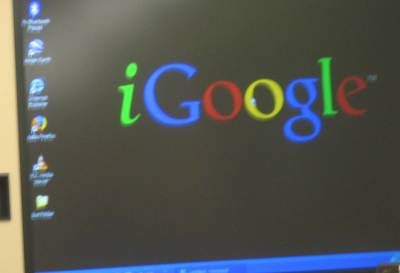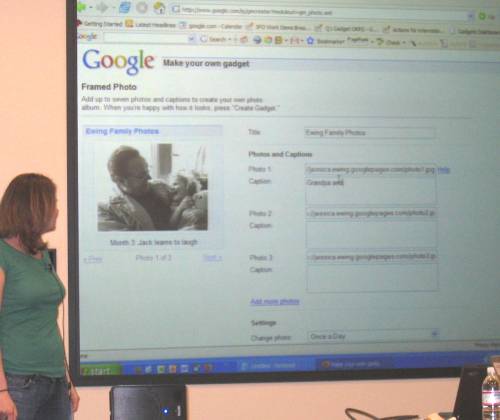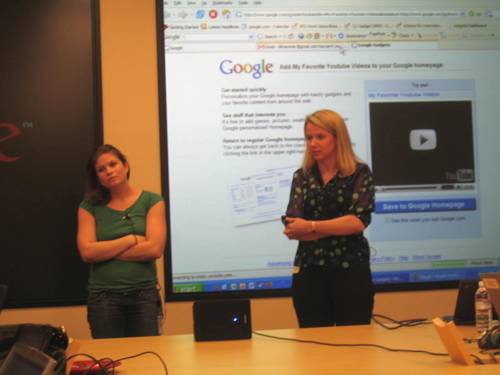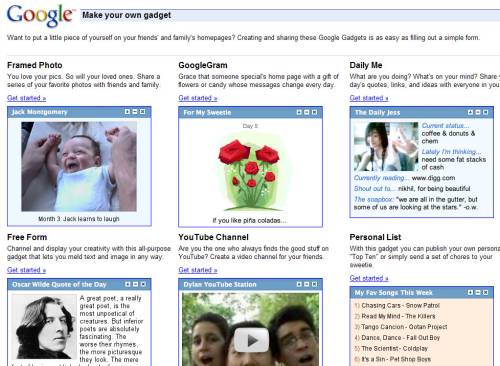Monday, April 30, 2007
Google Personalization Workshop: Gadget Maker and More
Today, Google is having a workshop (along with product news) on Google’s personalization services. Colin Colehour will be reporting live from the Googleplex event for us and I’ll be updating the post with new info as it comes in. Speakers will include Marissa Mayer and Sepandar Kamvar. (Note: Colin worked as a contractor for the Google Partner Solutions organization for 1 year; he’s currently working on personal projects from home.)
Overview:
- Marissa Mayer on iGoogle
- Sep Kamvar on personalization, and an announcement of personalized location results
- Jessica Ewing: iGoogle fastest growing product at Google in 2006
- Customizing the Google personalized homepage, and the new “iGoogle" name and logo
- Google announces Gadget Maker
- Google announces “My Community” feature as part of the iGoogle directory
- Googleplex impressions
Marissa Mayer on iGoogle
After brunch, the program started at 12:00pm Mountain View time. Marissa Mayer talks about how many people want Google to be faster, and what they did to improve PageRank calcuations.
Marissa says the Google Personalized Homepage was thought up in 2004. The original mockup had a logo of “iGoogle” (and the URL for the service – google.com/ig – makes everyone think the product name is Google IG.) But Google decided they really wanted the personalized homepage to be a feature, not a product. Hence, it doesn’t have a particular name until today. And while Marissa was calling it “iGoogle,” its actual codename was “Mockingbird.” At the end of this brief excursion, a new “iGoogle” logo is seen on the wall...
Sep Kamvar on personalization, and an announcement of personalized location results
Sepandar Kamvar (pictured) talks about Google’s personalization efforts. Why does Google invest in a “personal Google” now? Sep says it’s because of recent trends in content on the web, and recent technological advances in search algorithms. He suggests that Google wants to compute PageRank for every single person, so to speak. Sep explains that Google thinks of personalization in 3 parts:
- Search Your own stuff (like Google Desktop Search, Web History)
- Traditional (Pull) Search
- Push Search (like recommendations, iGoogle/ personalized homepage)
Still, Sep says they want to put the user in charge. For instance, Google makes personalization optional, Sep says, and you can pause the Web History feature (or remove specific items from the history). He goes on to mention that you can also export your Web History as RSS feed, giving the user more control over their data.
Sep continues with the classic disambiguation problem: a user is searching for “jaguar,” which could mean either the car, or the animal (or even the operating system). Google, of course, wants to show the user what they’re really interested in; if your search history reveals you’ve been looking for a new car, then a personalized result for “jaguar” should be geared more towards cars as well. Sep emphasizes that users should be able to find what they’re looking for without having to come up with the “perfect query" for what they are searching for.
Sep illustrates Google’s personalization efforts with a query for “surfing lessons.” He is now getting results tailored to his locations; his default Google Maps location is set to where he lives, information which will be tied into his Google searches as well. To quote from a Google announcement that is handed out at the workshop:
Google has launched location-based personalized search results. For those users who have provided a default location in Google Maps, Google will personalize results based on that location. For example, if a user has entered a default location into Google Maps and types in “library”, the results will bring up the user’s local library.
Jessica Ewing: iGoogle fastest growing product at Google in 2006

Now, Jessica Ewing – product manager of the Google Personalized Homepage program – is speaking. The technology of AJAX, which allows fluent page updates & client-server data exchange without having to reload a page, is one reason why Google has entered the customizable concept of Personalized Homepages, Jessica says. She goes on to say that content is changing on the web, and traditional web search wasn’t meant to answer the question “What do I want to see?”. This is one of the reasons why Personalized Homepage was created - to show you what you want to see.
Jessica goes on to mention that iGoogle will now be available in 40 countries and 26 languages*. She says that are now over 25,000 different Google gadgets that you can put on your iGoogle page, and that this was the fastest growing product at Google in 2006. Who’s developing all these gadgets? Among the developers are Wisgary Torres, whose modules receive 250,000 page views a week (I’m unsure if page view may equal just loading the Google homepage – if so, this value may be somewhat bloated). And then there’s Caleb Eggensperger, who according to Jessica developed several gadgets over the weekend. His gadgets now get “6.5 million page views a week.”
Jessica explains the concept behind the Google gadget directory. “Algorithms do a better job than we can,” she says – apparently, all gadgets in the directory are ranked algorithmically & automatically. And some gadgets don’t need to be manually picked from the directory, either. Jessica shows how Google uses IP-geolocation to optimize the gadgets displayed on iGoogle; for instance, a Harvard student might be shown feeds from Boston newspapers, based on his IP.
*These 18 new countries (15 languages) will be added to iGoogle, Google says: Turkey, Poland, Belgium (French and Dutch), Hungary, Romania, Vietnam (Vietnamese and English), Thailand (Thai and English), Ukraine, Greece, Portugal, Czech Republic, Columbia, Chile, Philippines, South Africa, Singapore, Austria, Malayasia, India (Hindi).
Customizing the Google personalized homepage, and the new “iGoogle" name and logo

Jessica Ewing says one of the first things people do when they boot up their new computer is to change the background image. These days, Google’s personalized homepage features wallpapers as well. Jessica notes that one of Google’s aims was to not make the themes too complex to view the content. At this time, themes have been adopted by 30% of the Google personalized homepage user base, Jessica says. Asked on how many user iGoogle have, Marissa Mayer says it’s “in the tens of millions.” Jessica adds that the new iGoogle logo will go live tonight... so the “Google Personalized Homepage” is now called “iGoogle.”
Google announces Gadget Maker
Jessica Ewing announces Google is going to release Gadget Maker today (claim: “no programming required”). There are 7 different types of gadgets that users can create with this tool. A new link at the bottom of your iGoogle page will allow you to access the Gadget Maker service. Jessica is showing the Framed Photo Gadget maker page (pictured above), walking us through how you would create a photo gadget. Once the gadget is created, you can invite other people to view & use the gadget, and make it publicly available for other people to view & use it.
The different types of “wizard” gadgets will cover:
- A Photo gadget (share a series of photos with others)
- GoogleGram gadget (allowing you to display a new greeting message to someone for every day for 7 days)
- Daily Me gadget (which will show what you’re currently doing, as well as quotes, what’s on your mind etc.)
- Personalized Countdown gadget
- A Personalized List (you can e.g. publish your own top ten list with this, Google says)
- YouTube video favorites gadget (pictured above, this gadget will let you create a YouTube channel to share)
- A “Free Form” gadget (an “all-purpose gadget that lets you meld text and image in any way,” Google says)
If you send a gadget invite to a friend, Jessica explains, it will send them an invite email similar to a Google Docs/ Spreadsheets invite. As the gadget will be immediately shown on the invite page, the user gets the chance to play around with the gadget without having to add it directly to their iGoogle page. This is good for people that haven’t used the iGoogle product and don’t know how it works, Jessica says.
Google announces “My Community” feature as part of the iGoogle directory
Tonight at 9pm Pacific Time, Google’s Jessica Ewing says they’ll be launching a “My Community” service as part of their personalized homepage directory. When you publish gadgets to the directory, they’ll ask for your location and name, and the location data will now be used for the “My Community” section to be more localized for your area. These gadgets will be able to be posted anywhere on the web, Google says, just like the gadgets which are currently available (and Google Desktop should be able to use these as well).
Googleplex impressions
>> More posts
Advertisement
This site unofficially covers Google™ and more with some rights reserved. Join our forum!












